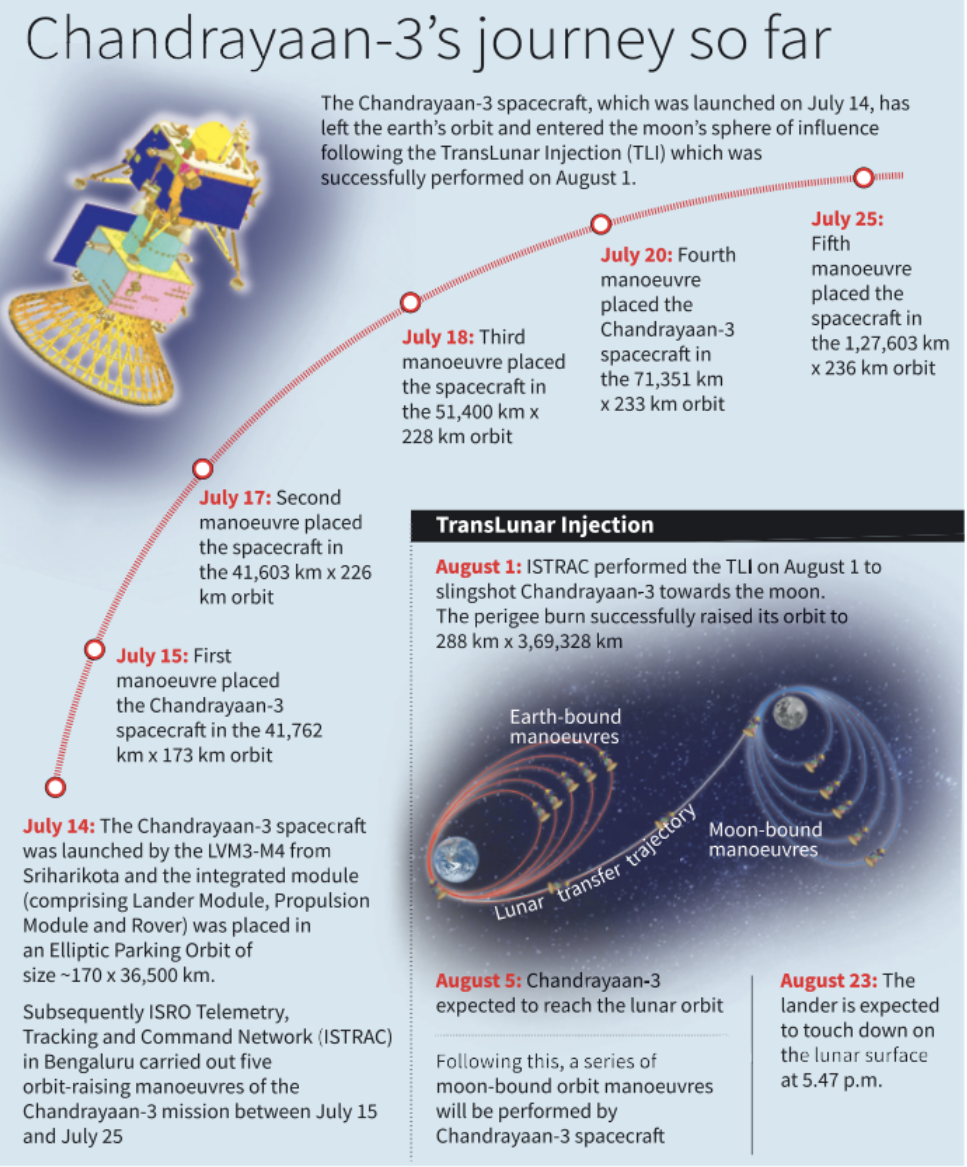Description

Disclaimer: Copyright infringement not intended.
Context
- On August 1, 2023, the Indian Space Research Organisation (ISRO) achieved a significant milestone by successfully performing the Translunar Injection (TLI) manoeuvre for the Chandrayaan-3 mission.
- The TLI was executed from the ISRO Telemetry, Tracking, and Command Network (ISTRAC) in Bengaluru.
Details
Translunar Injection (TLI) Process
- During the TLI manoeuvre, Chandrayaan-3 completed its orbits around the Earth and was propelled towards the Moon.
- A successful perigee-firing was performed at ISTRAC, which effectively injected the spacecraft into its translunar orbit. This step is critical for breaking free from Earth's gravity and setting the spacecraft on course towards the Moon.
Upcoming Lunar Orbit Insertion (LOI)
- The Chandrayaan-3 mission is expected to reach the lunar orbit on August 5.
- To achieve this, the spacecraft's liquid engine will be fired again in a maneuver known as the Lunar-Orbit Insertion (LOI).
- Once successfully completed, the spacecraft will be inserted into a lunar orbit.
Final Approach to the Moon
- After the LOI, the spacecraft will undergo four more orbit maneuvers to position itself into its final orbit, at a distance of approximately 100 km from the Moon's surface. This orbit is the desired configuration for the mission's objectives.

About
- Translunar Injection (TLI) is a crucial manoeuvre used in space missions to send spacecraft from Earth's orbit to the orbit of the Moon.
- It is a critical step in lunar missions, allowing spacecraft to break free from Earth's gravity and begin their journey to the Moon.
Purpose of Translunar Injection
- The primary purpose of Translunar Injection is to accelerate a spacecraft to a velocity that allows it to escape Earth's gravitational influence and enter a trajectory that will carry it towards the Moon.
- Before TLI, the spacecraft is typically in a low Earth orbit (LEO), having been launched into space by a launch vehicle (e.g., a rocket).
- Without TLI, the spacecraft would continue orbiting the Earth indefinitely, unable to reach its destination.
Execution of Translunar Injection
Executing Translunar Injection involves a precise and carefully calculated manoeuvre. The process generally involves the following steps:
- Earth Orbit: After launch, the spacecraft is placed into an initial Earth orbit, typically a low or medium Earth orbit.
- Alignment: The spacecraft must be correctly oriented and aligned with its engines pointing in the right direction for the TLI burn. This alignment is critical for ensuring the spacecraft's trajectory is accurate.
- TLI Burn: The spacecraft's propulsion system, usually its main engines, is fired for a specific duration to provide the necessary velocity increase. This burn adds energy to the spacecraft, allowing it to achieve the required escape velocity to break free from Earth's gravity.
- Translunar Trajectory: Once the TLI burn is completed, the spacecraft follows a trajectory that takes it towards the Moon. The trajectory is carefully planned to ensure that the spacecraft intercepts the Moon's orbit.
Challenges of Translunar Injection
Translunar Injection is a complex and critical manoeuvre that requires overcoming several challenges, including:
- Precise Calculations: Accurate calculations are essential for the TLI burn, considering variables like spacecraft mass, engine performance, and orbital position. Small errors in these calculations can lead to significant deviations in the trajectory.
- Timing: The timing of the TLI burn is crucial. It must be executed at the right moment to ensure the spacecraft reaches the Moon at the desired time and location.
- Propulsion Efficiency: The spacecraft's propulsion system must provide sufficient thrust and efficiency to achieve the required escape velocity within a reasonable timeframe.
- Navigation and Control: Navigational systems must be precise to monitor the spacecraft's position and make necessary course corrections during the journey.
Historical Significance
Translunar Injection has played a crucial role in numerous historic lunar missions. Some notable examples include:
- Apollo Missions: The Apollo program, conducted by NASA in the 1960s and 1970s, used TLI to send astronauts to the Moon. The TLI burns were instrumental in placing the spacecraft on the correct trajectory for lunar orbit insertion and subsequent lunar landing.
- Lunar Orbiters: Various lunar orbiters, both manned and unmanned, have utilized TLI to reach lunar orbit and conduct scientific observations of the Moon.
- Chang'e Missions: China's Chang'e program, which includes both lunar orbiters and landers, also employed TLI to reach the Moon.
- Artemis Missions: NASA's Artemis program aims to return humans to the Moon, and TLI will be a critical component of these missions.
About ISTRAC
- The Indian Space Research Organisation Telemetry, Tracking, and Command Network, commonly known as ISTRAC, is a network of ground stations and facilities established by ISRO to support and manage satellite and spacecraft missions.
- ISTRAC plays a critical role in the success of India's space missions by providing communication, tracking, and control services for various satellites and spacecraft in orbit.
Functions of ISTRAC
- Telemetry: ISTRAC receives telemetry data from the satellites and spacecraft in orbit. Telemetry refers to the transmission of data such as the health status of the satellite, its position, orientation, and other vital parameters. This data is crucial for mission operators and engineers to monitor the spacecraft's performance and health.
- Tracking: ISTRAC operates a network of ground-based tracking stations that are strategically located to ensure continuous coverage of satellites and spacecraft as they move across the sky. These tracking stations use radio antennas to track the spacecraft and determine their position accurately.
- Commanding: ISTRAC is responsible for sending commands to the satellites and spacecraft to perform various functions, such as adjusting their orbits, activating scientific instruments, or conducting specific maneuvers.
- Control: ISTRAC helps control the spacecraft's attitude (orientation) and orbit, ensuring that the satellite is correctly positioned and oriented as required for its mission objectives.
- Orbit Determination: By tracking the spacecraft from multiple ground stations, ISTRAC can accurately determine its orbit and trajectory. This information is essential for mission planning and execution.
- Mission Planning and Support: ISTRAC assists in the planning and execution of various space missions, including lunar missions, satellite launches, and interplanetary missions.
- Emergency Operations: In case of any contingencies or emergencies, ISTRAC is responsible for coordinating the response and recovery efforts to ensure the safety and continuity of the missions.
Locations and Facilities
ISTRAC has several ground stations and facilities located across India and abroad to provide comprehensive coverage and support for different missions. Some of the key locations include:
- ISTRAC Ground Station, Bengaluru: The main control center and headquarters of ISTRAC are located in Bengaluru, Karnataka. It serves as the nerve center for mission control and communication with spacecraft.
- ISTRAC Ground Station, Lucknow: Located in Lucknow, Uttar Pradesh, this ground station provides support for satellite tracking and mission operations.
- ISTRAC Ground Station, Biak, Indonesia: This station is located in Biak, Indonesia, and is used to track and support various missions.
- ISTRAC Ground Station, Mauritius: The Mauritius ground station provides coverage for missions over the Indian Ocean region.

Conclusion
Translunar Injection is a fundamental maneuver that allows spacecraft to break free from Earth's gravity and begin their journey to the Moon. Its successful execution requires precise calculations, efficient propulsion systems, and precise navigation. As humanity continues to explore space, TLI will remain a key element in lunar missions and beyond.
MUST READ ARTICLES:
https://www.iasgyan.in/daily-current-affairs/chandrayaan-3-1
https://www.iasgyan.in/daily-current-affairs/chandrayaan-3-mission
|
PRACTICE QUESTION
Q. Discuss the significance of Translunar Injection (TLI) in space missions, particularly in the context of lunar exploration. Highlight India's achievements in TLI and its relevance for the country's space program. (Answer in about 250 words)
|
https://www.thehindu.com/sci-tech/science/isro-successfully-conducts-translunar-injection-of-chandrayaan-3/article67143826.ece











